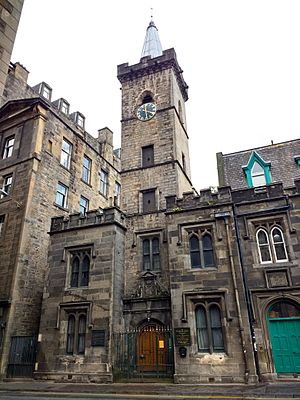Magdalen Chapel, Edinburgh facts for kids
Quick facts for kids Magdalen Chapel |
|
|---|---|

Magdalen Chapel, Cowgate, Edinburgh
|
|
| Lua error in Module:Location_map at line 420: attempt to index field 'wikibase' (a nil value). | |
| Location | Cowgate, Edinburgh |
| Country | Scotland |
| Denomination | Inter-denominational |
| Previous denomination | Roman Catholic, Church of Scotland, Baptist, Episcopalian |
| History | |
| Founded | 16th century |
| Architecture | |
| Heritage designation | Category A listed building |
| Designated | 14 December 1970 |
The Magdalen Chapel (also called Magdalene Chapel) is a historic building from the 1500s. You can find it on Cowgate in the Old Town of Edinburgh, Scotland. It's a very important building, officially known as a Category A listed building. This means it's protected because of its special history and design.
Contents
History of the Chapel
The Magdalen Chapel was built between 1541 and 1544. The money for it came from Michael MacQueen, who passed away in 1537. His wife, Janet Rynd (or Rhynd), added more money to the project.
The chapel was meant to be a place for a chaplain (a religious leader). It also served as an almshouse, which is a home for poor people. Seven poor men lived there and were asked to pray for the soul of Mary, Queen of Scots. Before the Scottish Reformation, Mary of Guise, who was Queen Regent at the time, even arranged academic lectures there.
Changes After the Reformation
After Janet Rynd passed away in 1553, a group called the Incorporation of Hammermen took over the chapel. They were a guild of metalworkers.
The Scottish Reformation brought big changes. The chapel was originally for Roman Catholic worship. But after the Reformation, a Protestant minister replaced the Catholic chaplain. This caused some problems because the chapel's original rules said it had to stay Catholic.
Because of these changes, some people stopped paying rent to the Hammermen. The Hammermen had to use their own money to keep the chapel going. From 1596, the chapel also became the regular meeting place for the Convenery of the Trades of Edinburgh, which was a group of different trade guilds.
Important Meetings and Preachers
The General Assembly of the Church of Scotland held a meeting in the chapel in April 1578. Some people believe the very first General Assembly in December 1560 also took place there.
A famous reformer named John Craig preached in the chapel. He had been out of Scotland for many years, so he preached in Latin!
Later Uses of the Chapel
Over the years, the chapel was used by different religious groups. In the 18th century, it was used by Episcopalians and a Baptist group. A printing press was also located nearby, or possibly even inside the chapel, during that time.
In the early 1800s, a Protestant group called the Bereans used the chapel for worship. They followed the teachings of a former Scottish Presbyterian minister named John Barclay (1734-1798).
In 1857, the Hammermen sold the chapel to the Protestant Institute for Scotland. It was then used by the Edinburgh Medical Missionary Society.
Modern Restoration
Architects Simpson and Brown carried out a big restoration project on the chapel in 1992 and 1993. Today, the Magdalen Chapel is the main office for the Scottish Reformation Society.
Design Features of the Chapel
The Magdalen Chapel has many interesting design elements that tell its story.
Inscriptions and Panels
Above the main door, you can see an inscription that says: "He that hath pity upon the poore lendeth unto the Lord and the Lord will recompence him that which he hath given, Pro. XIX vers XVII." This means that if you help the poor, God will reward you.
A carved panel with a coat of arms was made by John Sawer in 1615. It was moved to its current spot in 1649. Inside, there's also panelling that lists gifts given by members of the Incorporation of Hammermen.
Architectural Additions
Around 1615, a semi-circular wooden platform was added at the east end of the chapel, changing its layout. The tower and spire were built around 1620. The chapel's bell was made in 1632 by a Dutch bell maker named Michael Burgerhuys.
The original ceiling, which is no longer there, was painted in 1725 by Alexander Boswall. It was painted "skye colour with clouds and a sin (sun) gilded in the centre." You can still see a small piece of this painted ceiling on the south wall.
Stained Glass Windows
The stained glass in the middle window on the south wall is very special. It shows the Royal Arms of Scotland and the Arms of Mary of Guise. This is the only stained glass window in Scotland that is still complete from before the Scottish Reformation.
Another stained glass window in the main south wall was created in 1893 by William Graham Boss.
Historic Items Inside
The chapel also holds some important historical items. There's a sword that is said to have belonged to Captain John Paton, a Covenanter. The Covenanters were a Scottish religious and political movement. You can also see the table that was used to prepare the bodies of Covenanters for burial after they were executed in the nearby Grassmarket.
Janet Rynd's tomb is in the southeast part of the chapel. It has her family's coat of arms and an engraved border.

